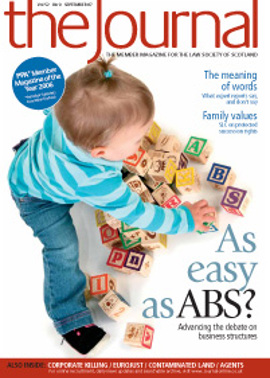Activity in the courts

There have been a number of interesting court decisions on rural matters recently and, rather than concentrate on a single topic, it may be helpful, for this issue, to summarise the most important. I do not, incidentally, include the important pronouncements of the sheriffs at Perth and Dingwall, respectively, in the Gloag and Tuley access cases, the latter of which is under appeal. There is sufficient to write about on agricultural law alone. Interestingly, perhaps, only the first case discussed relates to a point arising out of the Agricultural Holdings (Scotland) Act 2003.
In chronological order:
- Isle of Gigha Heritage Trust v Herd (SLC/176/06). On 11 May the Land Court determined that notice under s 72(6) of the 2003 Act, by which the former general partner in a limited partnership which is dissolved by the limited partner can claim the tenancy in his/her own right, falls to be issued within two months after the termination of the tenancy and that, accordingly, a notice issued prior to the termination of the tenancy was ineffective.
- A C Stoddart & Sons, Colstoun (1995) v Balfour Thomson 2007 SLT 593. On 1 June the Second Division (Lord Justice Clerk Gill in the chair), held on appeal that a break in an agricultural lease, available to the landlord only, opened up the right to a rent review under s 13(1) of the Agricultural Holdings (Scotland) Act 1991 to the tenant on the basis that it was a date at which “the tenancy could have been terminated by notice to quit (or notice of intention to quit)”, notwithstanding that the tenant could not make use of it for that purpose.
- Stephen v Duke of Roxburghe [2007] CSIH 42 (“the Cawdor case”). On 5 June the Second Division, Lord Gill again in the chair, held that the interests of joint tenants in an agricultural lease which had devolved, through succession, upon a single individual (who had perfected his right to those interests without objection by the landlord) had merged in his hands and, accordingly, a notice to quit given at a later date under s 25 of the 1991 Act in respect of a partial interest in the lease was incompetent. The court observed that notice to quit was not, in any case, competent to terminate a partial interest in a lease, being available only to terminate the tenancy of an agricultural holding, as such, in its entirety.
It should, incidentally, be noted that the similar case of Salvesen v Graham (2006 RN SLC/242/04) remains subject to appeal, although in his judgment in the Cawdor case, Lord Gill followed the approach taken by the Land Court in Graham in stating that a notice to quit was not available to terminate a partial interest in a tenancy.
- Johnstone v Milligan (SLC/170/06). On 12 July the Land Court held that an informal agreement under which a holding was let for “Period of let. Minimum 10 years” was a lease for the period of 10 years, the use of “minimum” being insufficient to stop the agreement being “a letting of land for a term of years” (1991 Act, s 85(1)). It was not, therefore, a Stirrat v Whyte situation. This decision has, however, now been appealed to the full court.
- Downie v Trustees of the Earl of Stair’s 1970 Trust [2007] CSIH 62. On 26 July the Second Division, the Lord Justice Clerk again presiding, upheld the Land Court’s earlier decision that an irritancy clause empowering the landlord to terminate the tenancy on a period of notice which did not, in theory, permit the tenant to make a claim for compensation for high farming was not void ab initio. It was, in fact, valid unless the landlord sought to enforce it in a way which prevented the tenant from claiming compensation (by, for example, giving less than two months’ notice) where the tenant had a live claim, in which case the clause was unenforceable to that extent only. The court went on to observe that, although the irritancy clause in question gave the landlords power to terminate the lease forthwith, it did not prevent them from terminating it at a deferred date which allowed the tenant the time to intimate his claim. The court therefore followed the approach taken by the Land Court in Broadlands Properties Ltd v Mann 2006 SLCR (1) 1 to the construction of a resumption clause entitling the landlords to resume “at any time or times”.
The reports of these cases are worth reading. The Second Division cases demonstrate, in my view, how lucky we are to have as our Lord Justice Clerk both the country’s foremost authority on agricultural law and one who is able to deliver judgments clearly and briefly.
Alasdair G Fox WS, Anderson Strathern
In this issue
- TUPE: stay your hand
- Nothing new under the sun
- ABS - Actual Benefit Soon?
- A chance to succeed?
- Killing in company
- Longer arm of the law
- Agents... a commercial view
- Bad language
- Remote gambling - all bets off?
- What makes a team?
- Managing the fraud risk
- Duties to the court
- Copycats: another nine lives?
- Activity in the courts
- Invoking the UCCJEA
- The men in black
- Scottish Solicitors' Discipline Tribunal
- Website reviews
- Book reviews
- Big names, big issues for annual conference
- Meet the Committee: Cameron Ritchie
- Contaminated land - where are we now?






